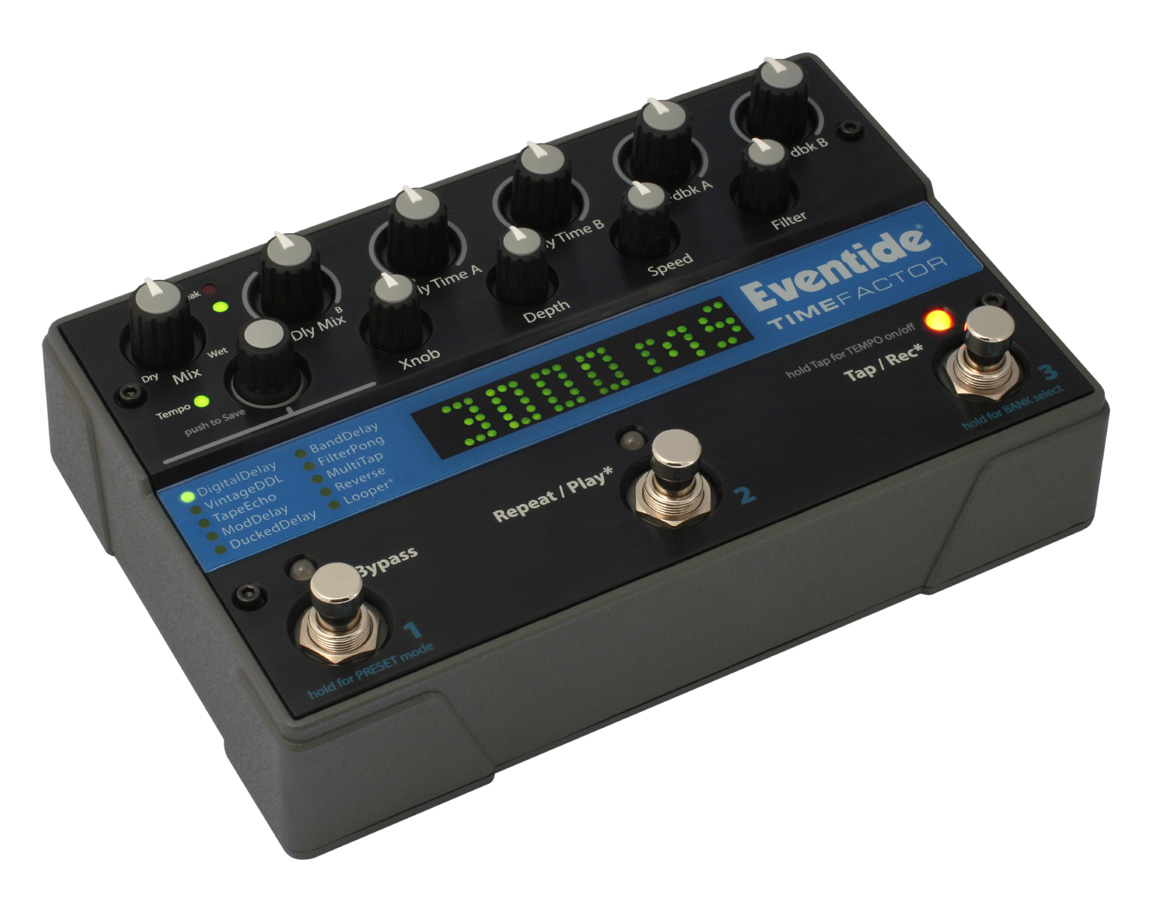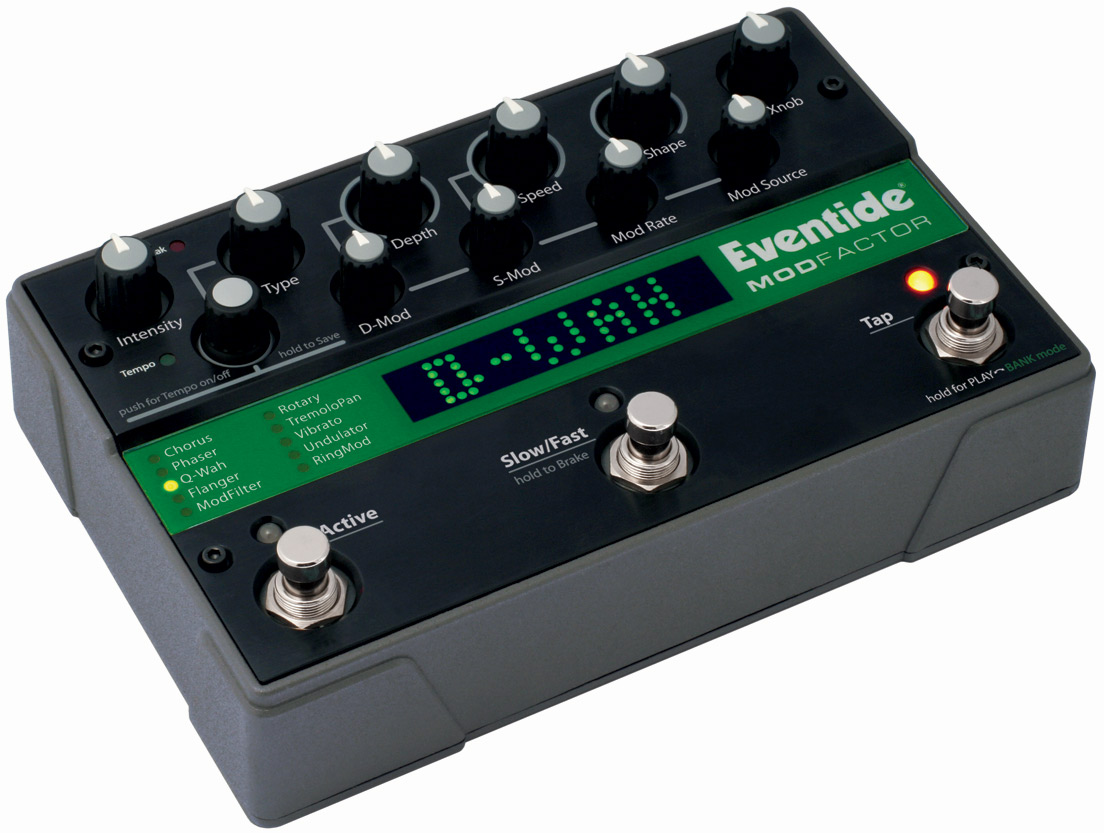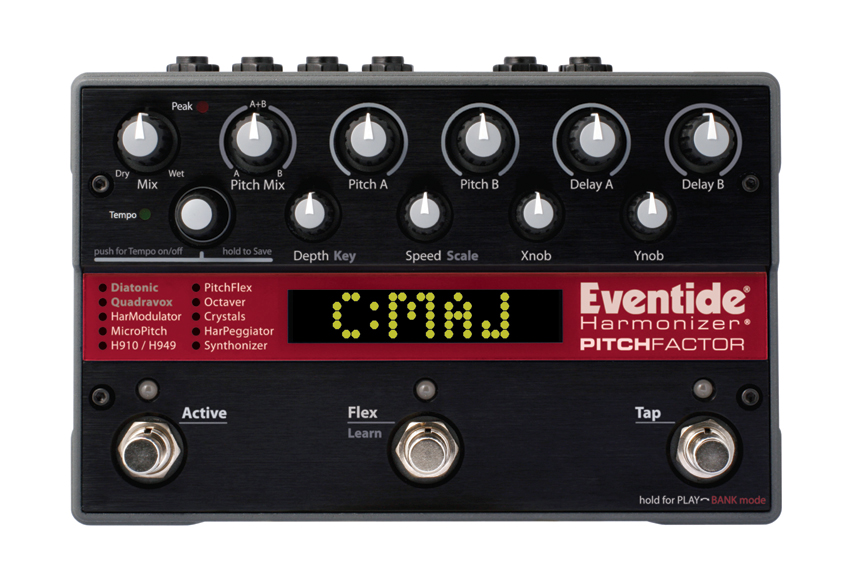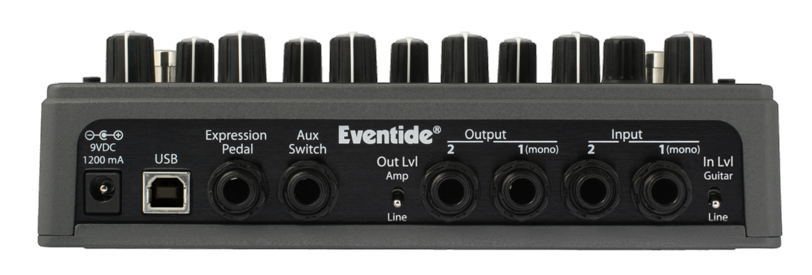

(Eventide Inducted into TEC Award Hall of Fame, 10/5/2007)



"Eventide Inducted into TEC Award Hall of Fame, 10/5/2007"
"Eventide Studio Quality Effects Pedals Information" Eventide Inducted into TEC Award Hall of Fame for H910 Harmonizer Pitch Processor 10/5/2007 - Anthony Agnello honored for developing original pitch processor — The prestigious TEC Awards Hall Of Fame Committee recently inducted Eventide for its 1974 innovation: the H910 Harmonizer® effects processor, which has been said to have turned music production on its head and ushered in a new era of music creation.
The Eventide H910 Harmonizer effects processor forever changed the complexion of music enabling producers and artists to add texture to their recordings and performances in ways heretofore unimaginable.
Yes vocalist, Jon Anderson, tested the first prototype. Users soon found all sorts of applications, ranging from regenerative arpeggios to bizarre sound design effects to lush guitar or vocal fattening.
Early customers included New York City’s Channel 5 putting an H910 to work, downward pitch shifting the audio portion of “I Love Lucy” reruns that were sped up to squeeze in more commercials. Music engineered on the H910 became the soundtrack of the seventies and eighties drawing praise and extensive use from a select group of top artists and producers.
Ideal for vocals, guitars and horns, the Eventide H910 was invented by then-engineer, now-chief technology officer, Tony Agnello. In 1974, Agnello conceived of a harmony processor but had little idea that he was creating a classic tool for the most successful artists of their generation. Jimmy Page was an early fan, incorporating the H910 into his guitar rack, and, similarly Frank Zappa employed it heavily as part of his guitar sound. Producer Tony Visconti used the H910 to achieve the now-legendary snare sound on David Bowie’s Young Americans, and Tony Platt did likewise on AC/DC's Back in Black. Eddie Van Halen and Steve Winwood also used the H910, each owning two of the units and incorporating them into their live and studio set-ups.
“I conceived the H910 as new kind of musical instrument. My goal was to give musicians and engineers a new way to create and sculpt music; to create an instrument that allowed them to change pitch, to add depth, and to layer harmonies,” Agnello said today.
“I was ecstatic that people like Frank Zappa and Tony Visconti embraced it and used it to explore new audio landscapes. After all, I was just a young engineer and we were a small company on the margins of the New York City studio community.
Now, we’re all a little older and a bit more established in the business, and the TEC Award Hall of Fame Award is especially gratifying.” The Eventide H910 offered pitch shifting and digital delay with feedback enabling subtle thickening on voices and guitar tracks. Since 1971, Eventide has evolved and grown and has become a staple in the music production community with various hardware and software tools for the artist and producer.
Studio Quality Effects at Your Feet
Top recording studios worldwide use Eventide effects on hit after hit.
TimeFactor includes Eventide's best delay effects from the past 36 years without
compromising quality OR flexibility.
Flexibility Built-In
Plug-and-play expression pedal control of wet/dry mix or any combination of
parameters. Control program changes and vary parameters continuously via MIDI.
Supports instrument or line level inputs and outputs. Plays well with others;
adapts seamlessly with a wide variety of amps and other foot pedals.
Obsolescence is so 20th Century
Easy to upgrade; download new software from the Internet and install via USB.
Features
•10 Stereo or Mono Delay effects
◦Digital Delay
◦Vintage Delay
◦Tape Echo
◦Mod Delay
◦Ducked Delay
◦Band Delay
◦Filter Pong
◦MultiTap
◦Reverse
◦Looper
•Studio Quality Sound
•Instant Program Change
•Real-time control with 10 knobs, MIDI or expression pedal
•Tap Tempo and MIDI Clock Sync
•40 User Presets, unlimited through MIDI
•True Analog Bypass
•Rugged cast metal construction
•Metal footswitches for instant Preset access
•Mono or Stereo operation
•Guitar or Line Level Inputs and Outputs

"ModFactor"
Studio Quality Effects at Your Feet
Premier recording studios worldwide use Eventide on hit after hit. ModFactor features Eventide's 27 best modulation effects without compromising quality OR flexibility.
Flexibility Built-In
Plug-and-play expression pedal control of wet/dry mix or any combination of parameters. Control program changes and vary parameters continuously via MIDI. Supports instrument or line level inputs and outputs. Plays well with others; adapts seamlessly with a wide variety of amps and other foot pedals.
Obsolescence is so 20th Century
Easy to upgrade; download new software from the Internet and install via USB.
Features
•27 of Eventide’s signature stereo or mono effects:
◦Liquid Chorus
◦Shimmer Chorus
◦Organic Chorus
◦Negative Phaser
◦Postive Phaser
◦BiPhase Phaser
◦Feedback Phaser
◦WahWah Q-Wah
◦Voc-Wah Q-Wah
◦Positive Flanger
◦Negative Flanger
◦Jet Flanger
◦Thru-o Flanger
◦Lowpass ModFilter
◦HiPass ModFilter
◦BandPass ModFilter
◦Standard Rotary
◦Giant Rotary
◦Bias Tremolo
◦Opto Tremolo
◦Modern Vibrato
◦Vintage Vibrato
◦Retro Vibrato
◦Pitch Undulator
◦Feedback Undulator
◦Ring (DC) Ringmod
◦String (AC) Ringmod
•Studio quality sound
•Software upgradeable via USB 2.0
•MIDI control via USB or MIDI in, out/thru
•Instant program change
•Real-time control with 10 knobs, MIDI, or expression pedal
•Tap tempo and MIDI clock sync
•40 factory presets, unlimited through MIDI
•True analog bypass
•Rugged cast metal construction
•Reliable metal footswitches for instant preset access
•Mono or stereo operation
•Guitar or line level inputs and outputs


Studio Quality Effects at Your Feet
Top recording studios worldwide use Eventide effects on hit after hit.
PitchFactor includes Eventide's best pitch-changing effects from the past 36
years without compromising quality OR flexibility.
Flexibility Built-In
Plug-and-play expression pedal control of wet/dry mix or any combination of
parameters. Control program changes and vary parameters continuously via MIDI.
Supports instrument or line level inputs and outputs. Plays well with others;
adapts seamlessly with a wide variety of amps and other foot pedals.
Obsolescence is so 20th Century
Easy to upgrade; download new software from the Internet and install via USB.
Features
•10 of Eventide’s signature stereo or mono pitch+delay effects:
◦Diatonic
◦PitchFlex™
◦Quadravox™
◦Octaver™
◦HarModulator™
◦Crystals™
◦MicroPitch
◦HarPeggiator™
◦H910 / H949
◦Synthonizer™
•Up to 4 voices of diatonic pitch shifting and up to 1.5 seconds of stereo delay
•Studio quality sound
•Guitar or bass compatible
•Built-in Tuner
•Software upgradeable via USB 2.0
•MIDI control via USB or MIDI in, out/thru
•Instant program change
•Real-time control with 10 knobs, MIDI, or expression pedal
•Tap tempo and MIDI clock sync
•100 factory presets, unlimited through MIDI
•True analog bypass
•Rugged cast metal construction
•Reliable metal footswitches for instant preset access
•Mono or stereo operation
•Guitar or line level inputs and outputs


In common
The Eventide TimeFactor and ModFactor stomp boxes are physically identical pedals, except for their colors and knob labeling. Along the back there are two 1/4” unbalanced input jacks, Left (Mono) and Right, with 500k ohms of impedance. A single toggle switch allows you to switch between Guitar level and Line level for both inputs. The two outputs, also Left (Mono) and Right, as also unbalanced 1/4” phone jacks, switchable between Amp and Line level. This configuration offers great flexibility—you can put the processor between your guitar and amp, or onto an amp’s effects loop, or even an aux send/return on a mixing console.
Next in line are two more 1/4” phone jacks, one for hooking up a three-way auxiliary foot switch and one for an expression pedal. Next, there is a USB Type B jack for hooking up to a PC for MIDI and fir mware updates. Finally, there is a 9VDC adapter outlet for hooking up the requisite wall wart to power the unit; battery power is not an option.
Along the right side of the unit are two standard MIDI 5-pin DIN connectors—MIDI In and MIDI Out/Thru. On the top of the unit are 11 knobs, an LED ‘billboard’ to show the current parameter being changed, bank selection, etc., and three metal foot switches labeled Active on the left, Slow/Fast for the ModFactor or Repeat on the Delay Factor for the middle, and Tap on the right.
Bypass and MIDI
It’s also worth noting that the two Factor pedals have three different types of audio bypass: DSP Bypass, Relay Bypass, and DSP+DLY Bypass. The DSP bypass is an electronics bypass of the effects processor. The Relay Bypass will ‘hard wire’ bypass the audio signal path. The DSP+DLY bypass allows the current effect to be bypassed without abruptly killing the tail of the effect that’s still playing.
The addition of MIDI and USB ports is another very cool feature for a stomp box. It’s possible to do things like set your DAW’s host to send patch change information to the pedal or dump out your custom edited patches as System Exclusive (.syx) files. Total recall of patch information without having to touch the unit on a per song basis for a stomp box is just oh so nice. Do note—only USB or MIDI is active, but not both at the same time.
Now let’s dig in and see what differentiates each pedal.
Eventide ModFactor
The ModFactor has a total of ten effects to choose from: Chorus, Phaser, Q-Wah, Flanger, ModFilter, Rotary, TremoloPan, Vibrato, Undulator, and RingMod. There are 40 user presets.
Each of the individual effects offers two to four different types of effects. For example, the Chorus offers a Liquid, Organic and Shimmer type, and the Phaser has Negative, Positive, Feedback and BiPhase types. Each effect has access to two LFOs (Low Frequency Oscillators) to modulate the sound.
The ModFactor has two rows of knobs, six along the top and five directly below those. The top row consists of Intensity, Type, Depth, Speed, Shape, and Xnob. The Xnob parameter modifies a parameter that’s unique to each effect. The bottom row which controls the second LFO consists of D-Mod, S-Mod, Mod Rate and Mod Source. The fifth and final knob is to toggle between tempo on and off (in musical divisions such as 1/64th, 1/8 dotted, 16th triplets, etc.) or in milliseconds, which is very cool. For classic-type modulation effects, the top row of knobs is all you’ll need. The bottom row of knobs allows the second LFO to modulate the first LFO, which is very cool.
These effects are truly a cut above the ‘average’ stomp box. While I thoroughly enjoyed all the effects, it was the Undulator effect that really makes this pedal scream “Eventide” to me. This liquid, over-the-top effect just rocks for slow, atmospheric playing on the guitar.
Eventide TimeFactor
The TimeFactor has 10 delay effects: Digital Delay, Vintage Delay, TapeEcho, ModDelay, DuckedDelay, BandDelay, FilterPong, MultiTap, Reverse, and Looper. Most notable is the Looper mode, which gives up to 48 seconds of mono recording time. Do note—high sound quality is only available in the 6- and 12-second mono recording mode; the 24- and 48-second mode takes a quality hit to extend the recording time past the 12-second recording buffer. There are 20 user presets.
The TimeFactor also has two rows of knobs, six along the top and five below that. The top six consist of Mix, Delay Mix, Delay Time A and B, and Feedback A and B, allowing independent adjustment of the two incoming delay lines into the unit. The knobs in the bottom row—Xnob, Depth, Speed and Filter—are specific to each of the previously mentioned effects algorithms. The fifth and final knob toggles between tempo on and off in musical divisions or in milliseconds, all the way up to 3000 milliseconds.
Delays are by far my favorite effects, and I own and use a lot of them, both in hardware and software, so it takes something a little special to make me go ‘wow’. With the TimeFactor, I had a real hard time keeping that smile off my face. Dense, warbly, spacious and rich, these delays have that Eventide signature sound written all over them. If you’ve ever wanted a delay that offers great special effects features as well as plain-Jane delay effects, this is the pedal to get.
Wish list
I have only one serious gripe with these amazing pedals. Why only 20 user presets on the TimeFactor and 40 user presets on the ModFactor? Even my old Yamaha FX550 guitar processor from 1995 has 50 presets plus 50 user editable programs. With such a good amount of settings and control, these Eventide units just beg to have at least 100 preset locations. Or maybe I’m just too spoiled by the high count of presets in Eventide’s top-tier processors?
Conclusion
Eventide has always had that little bit of something special to its sound. These new arrivals bring some of that special sound closer to the budgt-minded among us—and not just guitarists will be delighted by these pedals, as they work equally well with other instruments and synthesizers.
Sound sweetening has never been so good, or so affordable. These boxes are highly recommended by this keyboard- and guitar-slinging author.
Prices: $499 each